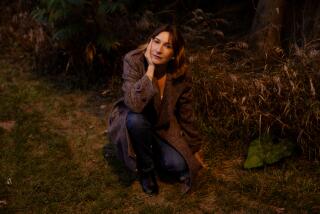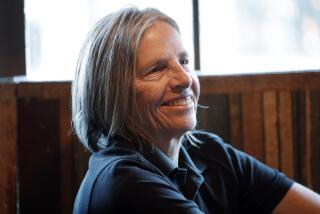When the mind falls into rhythm
- Share via
Imagination is a mysterious faculty, essential not only to the creation of art but also to the life of the mind itself. As the author of many acclaimed works of science fiction (perhaps a more accurate term would be fantasy), Ursula K. Le Guin knows a great deal about the workings of imagination and how important it is in transforming the raw material of experience into something new and strange.
In “The Wave in the Mind,” a collection of essays, talks and performance pieces, Le Guin defends the genre of fantasy literature (which includes science fiction) against its detractors:
“By saying fantasy is for children (which some of it is) and dismissing it as commercial and formulaic (which some of it is), critics feel justified in ignoring it all. Yet looking at such writers as Italo Calvino, Gabriel Garcia Marquez, Philip K. Dick, Salman Rushdie, Jose Saramago, it is possible to believe that our narrative fiction has for years been going, slowly and vaguely and massively, not in the wash and slap of fad and fashion but as a deep current, in one direction -- towards rejoining the ‘ocean of story,’ fantasy.
“Fantasy is, after all, the oldest kind of narrative fiction, and the most universal.”
Whether, as Le Guin suggests, a massive sea change in the direction of fantasy is actually underway, it is certainly true that fantasy is an ancient, enduring and vibrant part of literary tradition. Le Guin further argues that because fantasy is less culture-specific than realistic fiction, which is set at a particular time and place (Victorian England, Depression-era Chicago, Harlem in the 1920s), fantasy will have a broader appeal to readers in our unanchored, globalist age. This sounds logical enough, though I would still suspect that more readers respond immediately to the travails of Jane Austen’s village-bound heroines than to the timeless adventures of the knights in Edmund Spenser’s “The Faerie Queene.”
Although an eloquent advocate of fantasy and the creative imagination in general, Le Guin is equally adamant when it comes to drawing a line between fact and fiction. In her essay “Fact and/or/plus Fiction,” she takes direct aim at those who have tried to blur the line with specious arguments. Simply because it is true that nonfiction writers select and shape their material does not make nonfiction a form of fiction. Le Guin’s no-nonsense attitude is refreshingly clear and direct: “Whatever ‘creative’ means, I don’t think the term can be fairly applied to falsification of data and memories, whether intentional or ‘inevitable.’... Writers of nonfictional narrative who ‘create’ facts ... for the sake of aesthetic convenience, wishful thinking, spiritual solace, psychic healing, vengeance, profit, or anything else, aren’t using the imagination, but betraying it.”
For the fiction writer, she notes, creativity operates very differently. People often ask her where she gets ideas and characters for her stories, a question which shows that the questioner has no idea how the mind of a creative writer actually works. Borrowing an image from poet Gary Snyder, Le Guin compares the creative process to a compost heap where the stuff of experience accumulates and is transformed into fertile soil from which the seed of something entirely new grows.
Perhaps the most interesting and original part of Le Guin’s exploration of literary creation is her examination of the role played by rhythm. Le Guin believes rhythm is the heart of the process, its very pulse and breath. In “Stress-Rhythm in Poetry and Prose,” she not only analyzes the patterns of metered and free verse but also examines the subtler patterns of rhythm that are found in good prose. Then, looking beyond the line, the sentence and the paragraph, she draws our attention to the larger rhythms of narrative.
In her essay “Rhythmic Pattern in ‘The Lord of the Rings,’ ” she shows how Tolkien alternates scenes of lightness and darkness, warmth and cold, difficulty and reprieve, travel and rest to create an ongoing sense of movement and life -- what Le Guin calls the yin and yang of existence.
Indeed, so central is rhythm to Le Guin’s conception of writing that she has taken the title of her collection from a letter written by Virginia Woolf to Vita Sackville-West, which she quotes: “Style is a very simple matter: it is all rhythm. Once you get that, you can’t use the wrong words. But on the other hand here am I sitting after half the morning, crammed with ideas, and visions, and so on, and can’t dislodge them, for lack of the right rhythm. Now this is very profound, what rhythm is, and goes far deeper than words. A sight, an emotion, creates this wave in the mind, long before it makes words to fit it; and in writing ... one has to recapture this....”
The essays in this collection range all over the place, from Le Guin’s childhood memories of her “Indian Uncles” to a right-minded, if not very cogent, attack on genetic determinism. Certainly, it is an uneven collection: Some pieces are veritable gems, others fall flat, still others disconcertingly exude the rah-rah feel of a consciousness-raising group or a pep rally. But whether she is revisiting the story of Sleeping Beauty, taking issue with Tolstoy’s proclamation about happy families or bemoaning the stupid things women do to their feet in the name of fashion, Le Guin’s down-to-earth, intensely personal voice is unmistakable.
More to Read
Sign up for our Book Club newsletter
Get the latest news, events and more from the Los Angeles Times Book Club, and help us get L.A. reading and talking.
You may occasionally receive promotional content from the Los Angeles Times.










